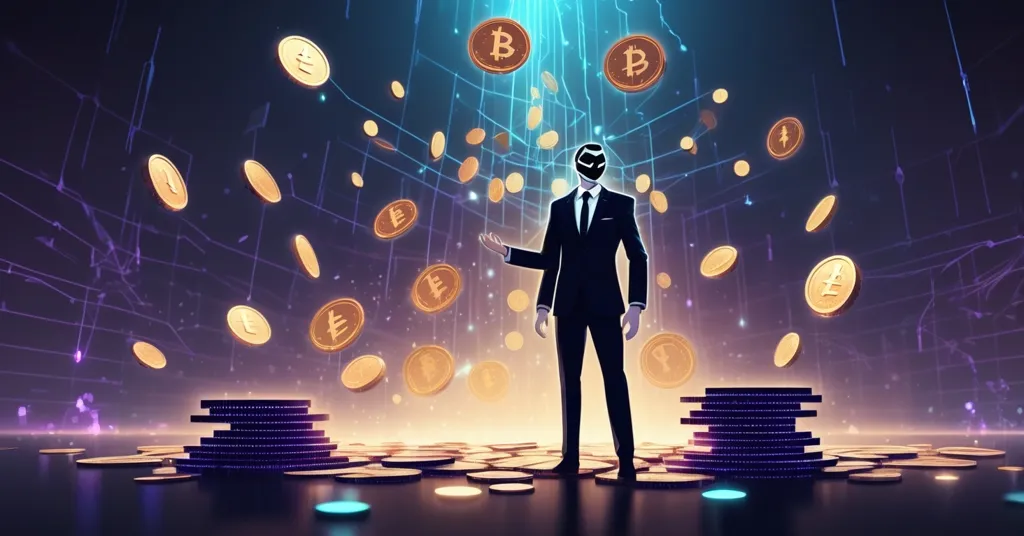WLFI Drops Presale, Launches Rewards with CEXs Amid Trump’s $57M Crypto Profit Controversy

WLFI Scraps Presale Plans, Unveils Rewards Program with Major Exchanges – Trump DeFi Drama Unfolds
World Liberty Financial (WLFI), the Ethereum-based DeFi project backed by President Donald Trump and his family, has put an end to speculation about new private token sales. Instead of another presale round, they’re rolling out a rewards program in partnership with major centralized exchanges (CEXs), aiming to broaden access to their governance token while navigating a storm of political and ethical scrutiny.
- No Insider Tokens at Launch: WLFI confirms no tokens held by co-founders, advisors, or team members will be available immediately after launch.
- Rewards Over Private Sales: A new program with top CEXs replaces presale rumors, focusing on letting users earn $WLFI tokens.
- Trump’s Massive Profit: A reported $57.3 million gain for Trump from token sales—potentially part of a $500 million family haul—fuels conflict-of-interest firestorms.
What is World Liberty Financial (WLFI)? Unpacking the Trump-Backed DeFi Project
Before we dig into the latest moves, let’s break down what WLFI actually is for those new to the crypto game. World Liberty Financial is a decentralized finance (DeFi) project built on Ethereum, one of the leading blockchains for smart contracts—think of them as self-executing agreements coded to run automatically without middlemen like banks. DeFi itself is like a peer-to-peer financial app, enabling lending, borrowing, or trading directly between users, all powered by blockchain tech. WLFI’s token, $WLFI, serves as a governance token, meaning holders can vote on key decisions for the platform, which aims to facilitate crypto lending and borrowing. But here’s the rub: there’s no live product yet. Right now, it’s a pile of promises, a hefty total supply of 100 billion tokens, and a whole lot of hype tied to a polarizing figure. For a deeper dive into the project, check out this comprehensive overview of World Liberty Financial.
The project initially sold tokens to the public at dirt-cheap prices of $0.015 and $0.05 per token. Only a fraction of these will unlock at launch, with the rest—along with over-the-counter (OTC) allocations, which are private, off-market deals often to big investors—and tokens reserved for the team, advisors, and founders, locked until community votes decide their release post-launch. This setup is a stab at transparency in a crypto space notorious for insider dumps and rug pulls, where project teams often sell off early and leave retail investors screwed. But with no working platform to show for it, WLFI is still a gamble wrapped in a shiny “liberty movement” bow. If you’re curious about its ties to Trump, here’s a discussion on what World Liberty Financial represents and potential pitfalls.
No Presale, Just Rewards: WLFI’s Pivot to Community Access
Rumors of a sneaky new presale had the community buzzing with distrust—backroom deals are a crypto red flag. WLFI shut that down hard with a statement on Twitter that left no room for doubt:
“We’re NOT opening another pre-sale round. Instead, we’re partnering with major exchanges to create a $WLFI reward program – allowing you to earn on platforms you already use and trust. A new path for everyone to join the liberty movement!”
Instead of catering to whale investors through another private sale, they’ve opted for a rewards program tied to major centralized exchanges—think potential giants like Binance or Coinbase, though no names or timelines have been confirmed. The idea is to let users earn $WLFI tokens through platforms they’re already familiar with, lowering the barrier to entry. DeFi trading options are also in the works for the more blockchain-savvy crowd. Initially, WLFI tokens were restricted to accredited investors—folks with high income or net worth (like over $200,000 a year or $1 million in assets in the U.S.) who can legally dabble in riskier, unregistered securities. But a community vote flipped that, opening access to retail buyers, a move that smells like democratization but could also just be a clever hype machine to boost demand. Learn more about this shift in their recent announcement on rewards instead of presales.
Timing remains a pain point. The WLFI team is holding off for what they call “one of the largest alignments yet,” teasing in a statement:
“Everyone wants $WLFI live ASAP – we get it! But we’re holding for one of the largest alignments yet… Patience will pay off.”
They even tossed in a cheeky jab: “A bit more patience ensures we do this right – so you can say ‘I told you so.’” Cute, but the vagueness stinks. A community vote on July 9, 2025, saw a staggering 99.94% of roughly 20,900 participants approve token tradability, hinting that listings on CEXs might be near. Still, no hard date means we’re all just twiddling our thumbs. In crypto, “soon” can feel like an eternity, and for a project tied to someone as divisive as Trump, delays only feed the skeptics—and the memes. For specifics on token distribution and voting, take a look at this update on WLFI’s tradability timeline.
Trump’s Millions: Profit and Politics Collide
While WLFI pushes for community trust with accessible earning opportunities, the shadow of its headline-grabbing backer looms massive—and massively profitable. President Donald Trump disclosed a jaw-dropping $57.3 million gain from WLFI token sales. Dig deeper, and some estimates suggest the Trump family’s total take since the project’s inception could be closer to $500 million, with Trump personally holding 15.75 billion of the 100 billion total $WLFI tokens and his company allocated 22.5 billion. That’s not pocket change; it’s a glaring neon sign screaming conflict of interest. Lawmakers, especially Democrats like Senators Elizabeth Warren and Representative Maxine Waters, have slammed it as “unprecedented,” warning that Trump’s dual role—shaping crypto policy while profiting big from a DeFi venture—could twist regulatory oversight in his favor. Former U.S. government ethics attorney Chris Swartz didn’t hold back either, calling it a “clear conflict of interest” and a potential pipeline for illicit payments. Dive into the criticism with this report on Trump’s profits and ethical concerns.
Let’s not sugarcoat this: it’s like having a referee also play quarterback—hard to trust the game won’t tilt his way. Trump’s broader crypto portfolio, including NFT ventures and rumored stakes in other digital assets, suggests WLFI isn’t a one-off but part of a calculated push into the space. Is this a genuine belief in decentralization, or just brand leverage with a side of market manipulation? Critics are betting on the latter, and frankly, the optics are trash. As Bitcoin maximalists, we’re all for disrupting centralized finance, but when the face of disruption is synonymous with top-down control, it’s a bitter pill to swallow. For community reactions, see this Reddit thread on Trump’s involvement in WLFI.
DeFi Risks: Governance, Delays, and Hype Over Substance
Investor sentiment around WLFI is a wild mix. Some are in for ideological reasons—cue the “make America great again” chants—while others are just chasing speculative gains. Take “Paolo,” a token holder who told Reuters he snapped up 95,000 $WLFI tokens for $5,000 and plans to hold until they hit $12 each. That’s not optimism; it’s borderline delusional in a market where 90% of altcoins bleed out. We’re not here to babysit dreamers or peddle price predictions—most of that noise is pure shilling bullshit. Know the damn risks before you YOLO into something backed by hype and a big name but lacking a working product. For more on the controversies, check out this detailed piece on Trump’s DeFi project issues.
DeFi history doesn’t exactly inspire confidence either. Remember Terra/Luna’s 2022 implosion? Billions vanished overnight due to shaky tokenomics and overpromised stability. WLFI’s governance model—where community votes decide token unlocks and protocol changes—sounds noble, but it’s a double-edged sword. Voter apathy or whale manipulation, where big holders (whales) use their outsized voting power to sway outcomes, can turn decentralization into a farce. Their website claims community input will shape “access and protocol development,” and social media echoes a mission of “building for the future.” But lofty ideals don’t pay the bills when execution fails or when the lack of a live platform leaves investors holding nothing but IOUs. Get a closer look at their partnerships and plans with this update on WLFI’s exchange collaborations.
Then there’s the irony of a project tied to a centralized figure like Trump preaching the gospel of decentralization. Can community voting truly offset such an inherent contradiction? On the flip side, let’s play devil’s advocate: Trump’s involvement could fast-track mainstream crypto adoption, dragging normies into DeFi with his megaphone of influence. Isn’t that worth the ethical mess if it accelerates the fight against traditional finance? Maybe, but only if WLFI proves it’s more than a flashy distraction. With no clear regulatory shield—despite a non-security status with the SEC—investors are still exposed to volatility, scams, and potential crackdowns, especially if Trump’s policy sway draws sharper scrutiny from bodies like the CFTC. For a broader perspective, read this analysis of WLFI’s DeFi ambitions.
What’s Next for WLFI? Key Takeaways and Questions for Crypto Investors
Let’s boil this down to the essential points and questions you should be mulling over if you’re eyeing WLFI or just watching the DeFi circus unfold. Here’s what we know and why it matters:
- What is World Liberty Financial (WLFI), and why is it a big deal in crypto?
WLFI is a Trump-backed DeFi project on Ethereum, focused on lending and borrowing through a governance token that lets holders vote on decisions. It’s a high-profile test of blending political clout with decentralized finance, making waves for both potential and controversy. - Why did WLFI ditch a new presale for a rewards program with exchanges?
To sidestep insider favoritism and build trust, WLFI nixed presale plans, instead teaming up with major centralized exchanges to let users earn tokens on familiar platforms, aiming to democratize access. - How does Trump’s $57.3 million profit from WLFI raise red flags?
It’s a screaming conflict of interest—Trump’s influence over crypto policy could bias regulations, with family earnings possibly hitting $500 million, drawing sharp criticism from lawmakers like Elizabeth Warren. - What risks does WLFI face as a DeFi project with no live product?
With no working platform, WLFI is pure speculation, open to governance failures, whale manipulation, and historical DeFi disasters like Terra/Luna’s collapse, while delays only deepen skepticism. - When will WLFI tokens be tradable, and what’s behind the delays?
No firm date exists despite a 99.94% community vote for tradability on July 9, 2025. Delays linked to a vague “large alignment” suggest strategic timing, but test patience in crypto’s fast-moving market.
So, where does this leave us? WLFI is a fascinating, messy experiment at the intersection of DeFi’s promise of financial freedom and the baggage of political celebrity. Their shift to a rewards program and community-driven token unlocks signals an intent to play fair—or at least look like they are. But with no live product, staggering financial stakes for the Trump family, and regulatory storm clouds brewing, it’s a high-stakes tightrope walk. As champions of decentralization, we’re rooting for any project that shakes the status quo of centralized finance, even if it’s an altcoin detour from Bitcoin’s pure ethos. Yet, the risks and stench of potential exploitation are impossible to ignore. Patience might pay off, as WLFI insists, but in crypto, hesitation can also burn you. Keep your skepticism sharp and your wallet guarded—this Trump card is far from a guaranteed win.



